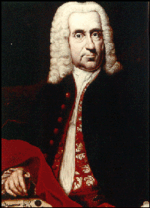Johann Heinrich Schulze
| Johann Heinrich Schulze | |
|---|---|
 Johann Heinrich Schulze | |
| Born | 12 May 1687 |
| Died | 10 October 1744 (aged 57) |
| Nationality | German |
| Institutions |
Altdorf Halle |
| Alma mater | Altdorf |
| Known for | silver chloride and silver nitrate darken in the presence of light |
| Influenced | Joseph Nicéphore Niépce |
History
Schulze studied medicine, chemistry, philosophy and theology and became a professor in Altdorf and Halle for anatomy and several other subjects.
Notable discoveries
Schulze is best known for the discovery that certain silver salts, most notably silver chloride and silver nitrate, darken in the presence of light, and for using those effects to capture temporary photographic images.[1] In an experiment conducted in 1724 he determined that a mixture of silver and chalk reflects less light than untarnished silver.[2] Though his discovery did not provide the means of preserving an image - the silver salts continued to darken unless protected from light - it did provide the foundation for further work in fixing images.
Joseph Nicéphore Niépce succeeded in photographing camera images on paper coated with silver chloride in 1816 but could not make the results light-fast.[3] The first permanent camera photograph of this type was made in 1835 by William Henry Fox Talbot. Other researchers in this field included Thomas Wedgwood and Sir Humphry Davy.[1]
See also
References
- ↑ 1.0 1.1 Leslie Stroebel and Richard D. Zakia (1993). The Focal encyclopedia of photography (3rd ed.). Focal Press. p. 6. ISBN 978-0-240-51417-8.
- ↑ Susan Watt (2003). Silver. Marshall Cavendish. pp. 21–. ISBN 978-0-7614-1464-3. Retrieved 28 July 2013. "... But the first person to use this property to produce a photographic image was German physicist Johann Heinrich Schulze. In 1727, Schulze made a paste of silver nitrate and chalk, placed the mixture in a glass bottle, and wrapped the bottle in ..."
- ↑ Niépce House Museum: Invention of Photography: 1816-1818, Niépce's first tries (retrieved 2012-11-01)
|